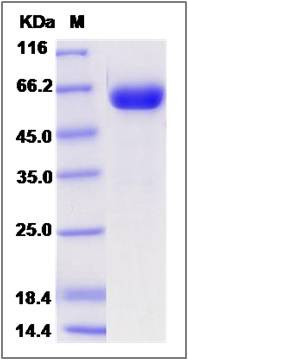Rat EphA7 / EHK3 Protein (His Tag)
Ehk-3,Ehk3
- 100ug (NPP3036) Please inquiry
| Catalog Number | P80109-R08H |
|---|---|
| Organism Species | Rat |
| Host | Human Cells |
| Synonyms | Ehk-3,Ehk3 |
| Molecular Weight | The recombinant rat EPHA7 comprises 523 amino acids and predicts a molecular mass of 58.9 kDa. The apparent molecular mass of the recombinant protein is approximately 59 kDa in SDS-PAGE under reducing conditions due to glycosylation. |
| predicted N | Gln 28 |
| SDS-PAGE |  |
| Purity | > 95 % as determined by SDS-PAGE |
| Protein Construction | A DNA sequence encoding the rat EPHA7 (Met1-Ser539) was expressed with a polyhistidine tag at the C-terminus. |
| Bio-activity | Immobilized rat EPHA7-His at 10 μg/ml (100 μl/well) can bind mouse EFNA4-Fc (P50595-M02H), The EC50 of mouse EFNA4-Fc (P50595-M02H) is 10.0-23.4 ng/ml. |
| Research Area | Cancer |Signal transduction |Growth Factor & Receptor |Ephrin & Eph Receptor |Eph Receptor |
| Formulation | Lyophilized from sterile PBS, pH 7.4. 1. Normally 5 % - 8 % trehalose and mannitol are added as protectants before lyophilization. Specific concentrations are included in the hardcopy of COA. |
| Background | Ephrin type-A receptor 7, also known as EphA7, belongs to the ephrin receptor subfamily of the protein-tyrosine kinase family which 16 known receptors (14 found in mammals) are involved: EPHA1, EPHA2, EPHA3, EPHA4, EPHA5, EPHA6, EPHA7, EPHA8, EPHA9, EPHA10, EPHB1, EPHB2, EPHB3, EPHB4, EPHB5, EPHB6. The Eph family of receptor tyrosine kinases (comprising EphA and EphB receptors) has been implicated in synapse formation and the regulation of synaptic function and plasticity6. Eph receptor-mediated signaling, which is triggered by ephrins7, probably modifies the properties of synapses during synaptic activation and remodeling. Ephrin receptors are components of cell signalling pathways involved in animal growth and development, forming the largest sub-family of receptor tyrosine kinases (RTKs). Ligand-mediated activation of Ephs induce various important downstream effects and Eph receptors have been studied for their potential roles in the development of cancer. Down-regulation of EphA7 secondary to hypermethylation has been reported in colorectal cancer. The expression of EphA7 was reduced in all tested gastric cancer cell lines; however, there is marked variability in expression among gastric carcinoma specimens. EphA7 may have roles in the pathogenesis and development of gastric carcinomas. |
| Reference |
